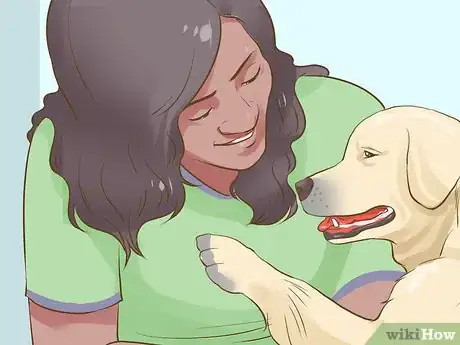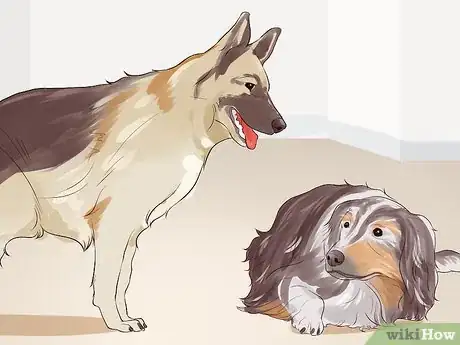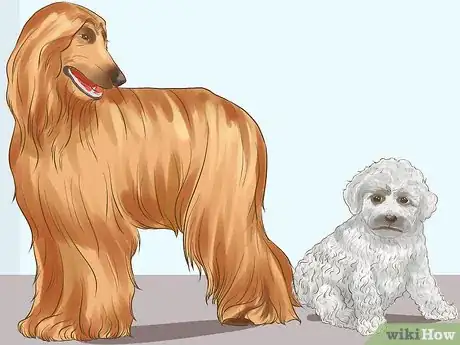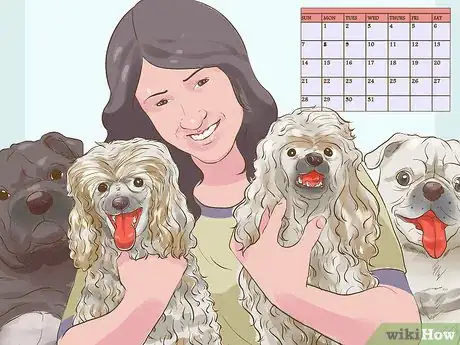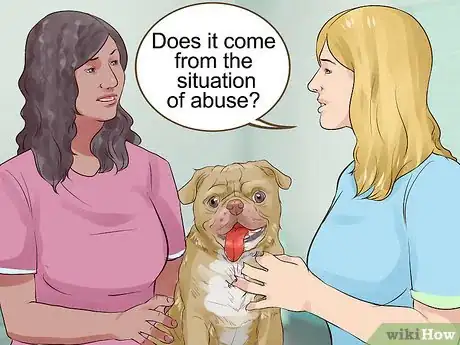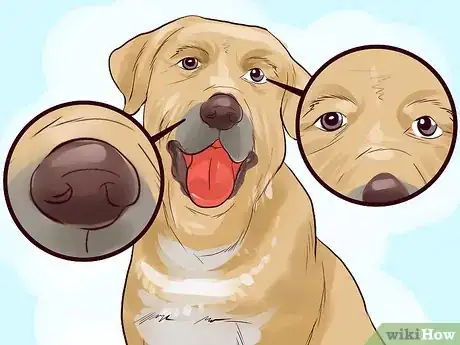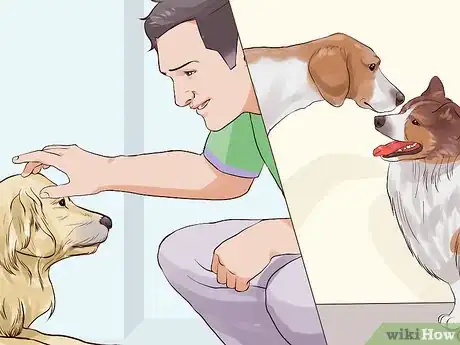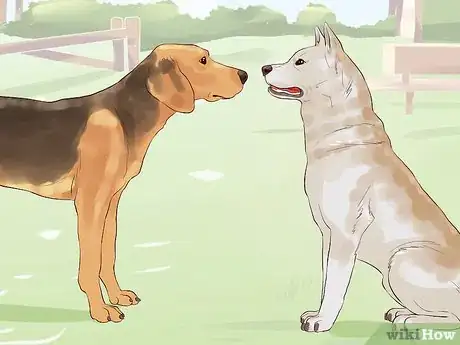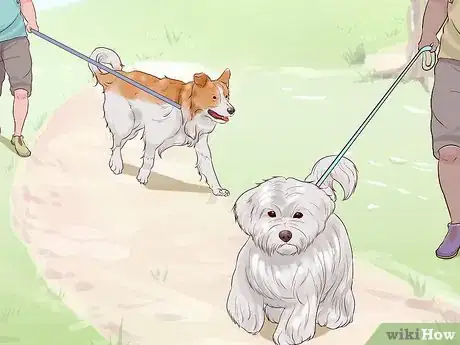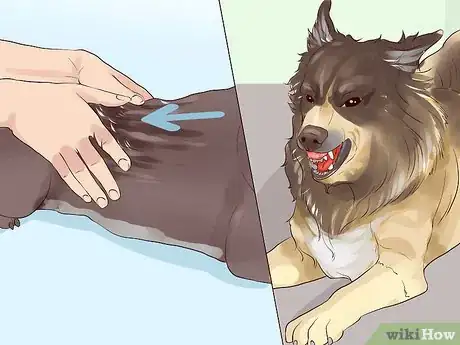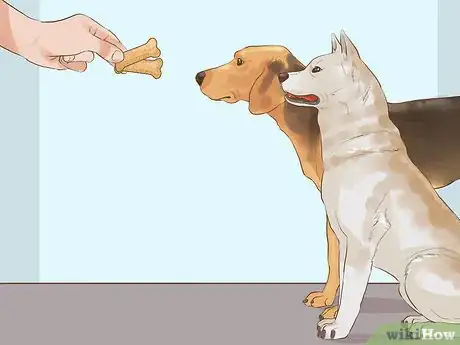This article was co-authored by Deanne Pawlisch, CVT, MA. Deanne Pawlisch is a Certified Veterinary Technician, who does corporate training for veterinary practices and has taught at the NAVTA-approved Veterinary Assistant Program at the Harper College in Illinois and in 2011 was elected to the board of the Veterinary Emergency and Critical Care Foundation. Deanne has been a Board Member of the Veterinary Emergency and Critical Care Foundation in San Antonio, Texas since 2011. She holds a BS in Anthropology from Loyola University and an MA in Anthropology from Northern Illinois University.
There are 7 references cited in this article, which can be found at the bottom of the page.
This article has been viewed 10,254 times.
Is your dog showing signs of loneliness? Do you think another dog may be the perfect solution? If you are interested in getting a companion dog, you’ll want to start by thinking about what kind of dog would best fit your lifestyle, and the needs of your current dog. Then, take some time looking at individual animals before adopting or buying. After you’ve gotten the new dog, calmly introduce the two and keep your fingers crossed that they become the best of friends!
Steps
Deciding on a Type of Dog
-
1Think about your motivations. Before you decide to add to your animal family, take a few moments to weigh the reasons behind your decision. You’ll want to make sure that your dog is actually indicating that it wants a companion, perhaps by whining or acting lonely. And, remember that adage that more dogs equal more work.[1]
- It is important to note that adopting a new dog will likely only worsen any behavioral issues, such as barking, that your current dog possesses. Don’t expect a new dog to be a bad behavior cure.[2]
- If you are considering getting a dog to replace one that has passed away, make sure to take your time. Dogs experience a grieving process as well and getting another dog too quickly could disrupt this.
-
2Decide on a breed. Take your dog to a play group or pet park and watch the interactions. See what types of dogs your pet gravitates toward in a positive way. What breeds of dogs does your dog seem to avoid or clash with? You could also observe interactions while attending an obedience class you’re your dog. Make sure that you consider both pure and mixed breeds.[3]
- For example, it is possible that your dog seems to enjoy playing with terriers, but is a bit afraid when encountering retrievers or shepherds.
- Make sure to consider the grooming and unique care needs of your new potential pet. If you already have a high maintenance dog, such as a poodle, you may want one requiring less care. Or, perhaps you plan to tote both dogs to appointments at once to save time.[4]
Advertisement -
3Consider your dog’s size and age. A puppy’s jumping and energy may be too much for an older dog to handle. However, an older dog may be more set in its ways and less likely to defer to your current dog. Likewise, a teacup or toy dog could be injured by an excitable large dog. Dogs who are close in size generally make the best play companions.[5]
- Again, the best bet here is to watch your dog in a natural play environment to see who it naturally chooses for companionship.
- It may seem like a good idea to make your older dog act as a babysitter for a younger puppy, but this can backfire. Your current dog might exhibit little patience with the pup and could even hurt it. Or, the puppy could run wild and develop bad behaviors, such as biting. Make sure to plan a training regimen if you consider a puppy.[6]
-
4Weigh choosing a male or female. Two dogs of the opposite sex are generally more likely to get along, as opposed to two of the same sex. And, a male-male pairing will likely be more peaceful than a female-female pairing. Again, you will want to watch your dog to see how they interact with the different sexes.[7]
- Make sure to get your dogs spayed or neutered. Not only does this help to control the pet population, it also often leads to better behavior.
-
5Consider your dog’s personality. All dogs have different traits and needs/wants. You’ll want to make sure that your dog is friendly, at a minimum, to other dogs. You’ll also want to think about whether or not your dog tries to establish dominance around other animals, or is content to be led. You want to find a companion dog that can bring out the best in your dog’s personality.[8]
- If your current dog’s behavior is a bit unruly, you may want to complete an obedience course prior to bringing in another dog.[9]
-
6Choose to adopt or purchase the dog from a breeder. Once you’ve narrowed down your preferences a bit, you’ll want to contact your local animal shelter to discuss the adoption process. This, or reaching out to an online adoption website (such as Petfinder), is generally the best way to locate a mixed breed dog. If you want a purebred dog, you’ll want to search for breeders in your area.
- You can go to the American Kennel Club (AKC) website to get more information regarding breeders operating in your area.
- Whether you choose a breeder or adoption, try not to visit the facility with your dog during the first go-round. This can stress out your dog and lead to a bad reaction.[10]
- There are breed-specific rescues for purebred dogs, as well as a number of purebred dogs in shelters in need of homes. Just because you want a specific kind of dog doesn’t mean you must go through a breeder.
- If you are looking for a puppy, you can find one via a breeder or adoption. If you are interested in a more mature dog, adoption is probably your best bet. You can search online for dog rescue groups in your area as well.
Choosing a Particular Dog
-
1Be patient. It’s highly unlikely that you will find a good match immediately after you start looking. Instead, be prepared to wait until you locate the best possible companion dog for your family. Keep up the search by checking in regularly with your adoption contacts. Use this time to keep observing your dog to learn more about what they might like.[11]
- If you choose to go with a puppy from a breeder, you may also have to get past the wait list and the holding period of 9-12 weeks before a puppy can be released.
-
2Talk with the dog’s owner or breeder. Whether you go through a breeder or rescue organization, make sure to ask about the dog’s history, if it’s available. Does it have a record of good interactions with other dogs? Does it come from a situation of abuse? Is there information available about the parents?
-
3Choose a healthy dog. To protect your current dog and avoid costly vet bills, you’ll want to find out as much as you can about the health status of your adoptee. Some illnesses, such as parvo, can pass from dog to dog. And, some puppies can be so sick that they pass away shortly after adoption, only causing more heartache.
- Look for dogs with clear eyes, clean noses and eyes, unobstructed breathing, and consistent outward behaviors. Ask to see medical records, if they are available.
- Getting another dog means that there is twice the possibility of some sort of medical issue. Make sure that you have some funds set aside in case something happens to your new dog.[12]
-
4Observe the dog interacting with people and other dogs. Even if you have to sit outside the kennel at an adoption facility, try to get some sense about how your potential adoptee has been socialized. Are they friendly overall or shy just at first? You want a dog that is not crippled by shyness, as that can turn into aggressiveness.
- If you feel safe, place your hand down to see how the dog reacts. The dog should be cautious, but curious. Offering a treat will make your first meeting even more positive.
-
5Try an overnight stay. Most rescue organizations and breeders will allow you to go on a trial run with your new dog. Bring the dog home and follow the introduction procedures outlined below. This brief visit, whether it be a few days or longer, will allow to see how this dog fits into your home life and the life or your current dog.[13]
Introducing the Two Dogs
-
1Go to a neutral location. You can introduce the two dogs in your home, or even in your backyard, but a totally ‘new’ spot, such as a park, is ideal. This means that neither animal will feel protective or defensive over the space. You could also contact a local dog trainer and ask for their assistance, and the use of their facility, for a few hours.[14]
-
2Proceed slowly and cautiously. Get two handlers, one for each dog, and have them hold the dogs leashed a good distance away from one another. The two handlers should slowly walk forward, pausing if they sense their dog is tensing up. This whole process should go slowly and methodically, which will help to calm the dogs as well.[15]
-
3Watch for any signs of aggression. Pause and pull the dogs back a bit (gently) if there are any signs of distress or agitation, such as growling or lunging. Ideally, the dogs will show a degree of curiosity and will keep their tails wagging the entire time.[16]
-
4Keep them separated when unsupervised. After the initial introductions are concluded, you can let both dogs off their leases if there are no signs of agitation. They will likely continue to sniff each other and play. However, when you move indoors it is a good idea to separate the dogs if you are not in the room and during meal times as well.[17]
- You can separate the dogs by using baby gates, closing certain doors, or even crating both of them for periods of time.
-
5Give positive attention to both dogs. It is important to provide visible and physical affection to both dogs throughout the introductory process and beyond. Give treats to them together. Buy toys for them separately and for them to play with together. Make sure that there are plenty of toys and treats, so that the dogs will not feel the need to compete.[18]
Warnings
- If there is any sign of aggression, separate your dogs for at least a few minutes.⧼thumbs_response⧽
- Be prepared that your dogs may not instantly, or even in the long-term, fall in love with one another. They may simply live in a state of agreeable cohabitation. Try to be okay with this and enjoy your dogs nonetheless.[20]⧼thumbs_response⧽
References
- ↑ http://shibashake.com/dog/getting-a-second-dog
- ↑ http://www.clickertraining.com/what-to-expect-introducing-a-puppy-to-your-adult-dogs
- ↑ http://shibashake.com/dog/getting-a-second-dog
- ↑ http://thebark.com/content/bringing-home-second-dog
- ↑ http://thebark.com/content/bringing-home-second-dog
- ↑ http://www.clickertraining.com/what-to-expect-introducing-a-puppy-to-your-adult-dogs
- ↑ https://indoorpet.osu.edu/dogs/new_additions_dogs/dog-dog-intro
- ↑ http://thebark.com/content/bringing-home-second-dog
- ↑ http://shibashake.com/dog/getting-a-second-dog
- ↑ http://3lostdogs.com/tips-for-successfully-adding-a-second-dog-to-your-family/
- ↑ http://shibashake.com/dog/getting-a-second-dog
- ↑ http://shibashake.com/dog/getting-a-second-dog
- ↑ http://shibashake.com/dog/getting-a-second-dog
- ↑ http://www.dogster.com/lifestyle/5-things-to-consider-second-dog
- ↑ http://shibashake.com/dog/getting-a-second-dog
- ↑ http://thebark.com/content/bringing-home-second-dog
- ↑ http://thebark.com/content/bringing-home-second-dog
- ↑ https://indoorpet.osu.edu/dogs/new_additions_dogs/dog-dog-intro
- ↑ http://www.dogsbestlife.com/home-page/help-your-older-dog-adjust-to-a-new-companion/
- ↑ http://www.clickertraining.com/what-to-expect-introducing-a-puppy-to-your-adult-dogs
About This Article
Before you get a new dog to keep your old dog company, keep in mind that a new dog might worsen any behavioral problems that your old dog has, like barking or chewing. You should take care of those issues before you get a new dog so you're not overwhelmed down the road. If you're not sure what kind of dog you should get, go with one that's around the same size and age as your old dog, since they'll be less likely to fight and have issues that way. Additionally, you might want to get a dog that's the opposite sex since same-sex pairings are more likely to have problems. Whichever kind of dog you decide to get, make sure it's friendly and well behaved so it's compatible with your old dog. For advice from our Veterinary co-author, like how to introduce a new dog to your old dog, keep reading!
